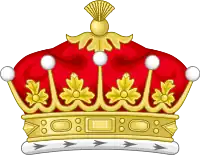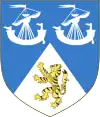| Earldom of Inchcape | |
|---|---|
  Arms: Per chevron Azure and Argent, in chief two Lymphads Argent, and in base a Bengal Tiger proper. Crest: A Cubit Arm holding a Falcon proper. Supporters: Dexter: a Lion rampant Gules. Sinister: a Bengal Tiger proper. both supporting a Pendant Argent, charged with a Saltire Gules. | |
| Creation date | 20 June 1929 |
| Created by | King George V |
| Peerage | Peerage of the United Kingdom |
| First holder | James Mackay, 1st Viscount Inchcape |
| Present holder | Peter Mackay, 4th Earl of Inchcape |
| Heir apparent | Fergus Mackay, Viscount Glenapp |
| Remainder to | 1st Earl's heirs male of the body lawfully begotten |
| Subsidiary titles | Viscount Inchcape Viscount Glenapp Baron Inchcape |
| Status | Extant |
| Motto | MANU FORTI (With a strong hand) |
Earl of Inchcape is a title in the Peerage of the United Kingdom.[1] It was created in 1929 for the Scottish shipping magnate and public servant James Mackay, 1st Viscount Inchcape.[2] He had been created Baron Inchcape, of Strathnaver in the County of Sutherland, in 1911,[3] and Viscount Inchcape, of Strathnaver in the County of Sutherland, in 1924.[4] He was made Viscount Glenapp, of Strathnaver in the County of Sutherland, at the same time as he was given the earldom. These titles are also in the Peerage of the United Kingdom.
The family seat is Carlock House near Ballantrae, Ayrshire. The former family seat was Glenapp Castle, which is now a luxury hotel. It was sold by the Mackay family in 1982, having been acquired by the 1st Earl of Inchcape in 1917. The present Earl of Inchcape, however, still owns the Glenapp Estate.
Earls of Inchcape (1929)
- James Lyle Mackay, 1st Earl of Inchcape (1852–1932)
- Kenneth Mackay, 2nd Earl of Inchcape (1887–1939)
- Kenneth James William Mackay, 3rd Earl of Inchcape (1917–1994)
- Kenneth Peter Lyle Mackay, 4th Earl of Inchcape (b. 1943)
The heir apparent is the present holder's only son Fergus James Kenneth Mackay, Viscount Glenapp (b. 1979).
The heir apparent's heir apparent is his son, the Hon. Alexander David James Mackay (b. 2017).
Line of succession
 James Lyle Mackay, 1st Earl of Inchcape (1852–1932)
James Lyle Mackay, 1st Earl of Inchcape (1852–1932)
 Kenneth Mackay, 2nd Earl of Inchcape (1887–1939)
Kenneth Mackay, 2nd Earl of Inchcape (1887–1939)
 Kenneth James William Mackay, 3rd Earl of Inchcape (1917–1994)
Kenneth James William Mackay, 3rd Earl of Inchcape (1917–1994)
 Kenneth Peter Lyle Mackay, 4th Earl of Inchcape (born 1943)
Kenneth Peter Lyle Mackay, 4th Earl of Inchcape (born 1943)
- (1) Fergus James Kenneth Mackay, Viscount Glenapp (b. 1979)
- (2) Hon. Alexander David James Mackay (b. 2017)
- (1) Fergus James Kenneth Mackay, Viscount Glenapp (b. 1979)
- (3) Hon. James Jonathan Thorn Mackay (b. 1947)
- (4) Aidan James Turner Mackay (b. 1978)
- (5) Hon. Shane Mackay (b. 1973)
- (6) Hon. Ivan Cholmeley Mackay (b. 1976)
- (7)
 Simon Brooke Mackay, Baron Tanlaw (born 1934)
Simon Brooke Mackay, Baron Tanlaw (born 1934)
- (8) Hon. James Brooke Mackay (b. 1961)
- (9) Hon. Brooke Brooke Mackay (b. 1982)
See also
References
- ↑ "No. 33509". The London Gazette. 25 June 1929. p. 4189.
- ↑ Hesilrige 1921, p. 500.
- ↑ "No. 28512". The London Gazette. 11 July 1911. p. 5169.
- ↑ "No. 32900". The London Gazette. 22 January 1924. p. 684.
Work cited
- Hesilrige, Arthur G. M. (1921). Debrett's Peerage and Titles of courtesy. 160A, Fleet street, London, UK: Dean & Son. p. 500.
{{cite book}}: CS1 maint: location (link)